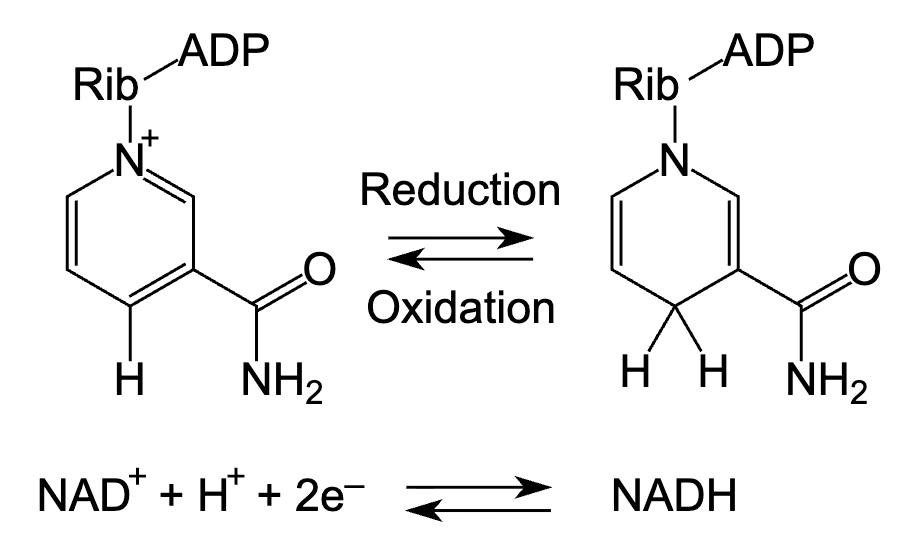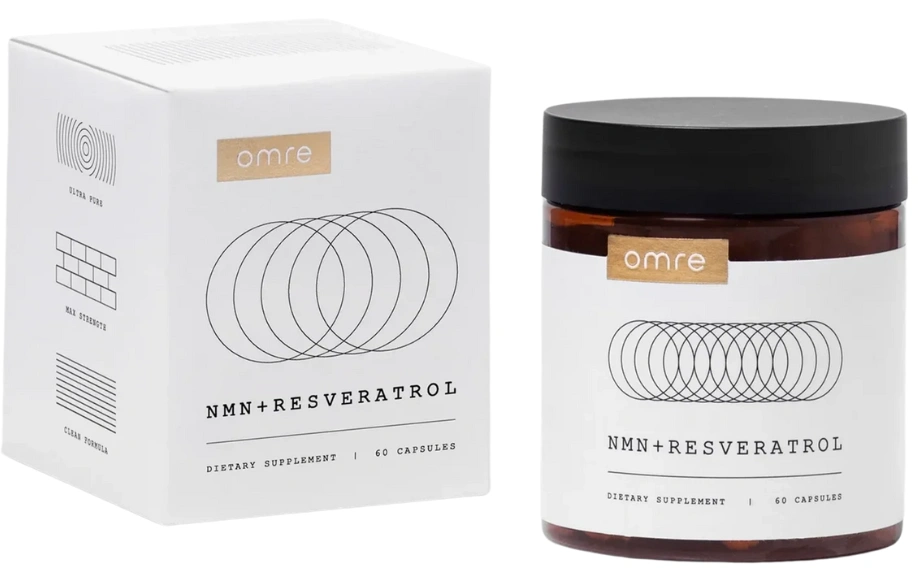Table of Contents
If you’ve ever wondered how your body turns food into energy, the answer lies in two molecules, NAD+ and NADH. They work together like delivery drivers inside your cells, moving energy from one place to another.
But how does NAD+ turn into NADH, and why does it matter for your health?
This guide explains the NAD+ to NADH conversion, why it’s vital for energy production, and how you can support healthy levels naturally.
Key Summary:
-
NAD+ and NADH power your cells. NAD+ collects electrons, while NADH delivers them to make ATP.
-
NAD+ becomes NADH during metabolism by gaining electrons and hydrogen.
-
A balanced NAD+/NADH ratio supports energy, metabolism, and DNA repair.
-
Boost NAD+ naturally with niacin-rich foods, exercise, good sleep, or NMN supplements.
NMN + RESVERATROL
Cellular NAD+ booster with ultra‑pure NMN and Resveratrol, at research‑backed doses.*
What is NAD+?
 NAD+, short for Nicotinamide Adenine Dinucleotide, is a coenzyme that helps your body turn food into energy. It starts the NAD+ to NADH cycle, picking up electrons during metabolism to create energy-rich NADH.
NAD+, short for Nicotinamide Adenine Dinucleotide, is a coenzyme that helps your body turn food into energy. It starts the NAD+ to NADH cycle, picking up electrons during metabolism to create energy-rich NADH.
Think of NAD+ as an empty shuttle bus moving through your cells, collecting electrons and delivering them where they’re needed to power energy production. Without enough NAD+, your cells can’t make energy efficiently.
NAD+ also supports DNA repair and activates sirtuins, enzymes that help regulate cellular health and longevity.
As you age, NAD+ levels naturally drop, which can lead to fatigue and slower metabolism. Keeping NAD+ levels steady supports better energy and overall cellular function (1).
What is NADH?
 NADH is the reduced form of NAD+. It’s created when NAD+ gains electrons and a hydrogen ion during metabolism, allowing it to act as an electron donor that fuels ATP production, your body’s main source of energy.
NADH is the reduced form of NAD+. It’s created when NAD+ gains electrons and a hydrogen ion during metabolism, allowing it to act as an electron donor that fuels ATP production, your body’s main source of energy.
Once NAD+ captures electrons, it becomes NADH, carrying energy to the mitochondria to power your cells. Think of it as a full shuttle bus delivering energy where it’s needed.
NADH also helps reduce oxidative stress by donating electrons that neutralize free radicals. Research suggests it may support brain function and reduce fatigue (2).
The ongoing cycle between NAD+ and NADH keeps your energy production steady and your cells healthy.
NAD+ vs NADH: Key Differences
NAD+ and NADH are two forms of the same molecule that work together in your body’s energy system. NAD+ is the oxidized form that accepts electrons to start energy production, while NADH is the reduced form that donates those electrons to generate ATP inside your cells. In simple terms, NAD+ collects energy, and NADH delivers it.
Both are vital for metabolism, but NAD+ also supports DNA repair and longevity pathways, making it the more influential form when it comes to healthy aging.
How Does NAD+ Become NADH?
 NAD+ becomes NADH through a reduction reaction, where it accepts two electrons and one hydrogen ion (H+) during metabolic processes such as glycolysis and the Krebs cycle. In simple terms, NAD+ gains energy by picking up these electrons and turns into NADH, which then carries this energy to the mitochondria to produce ATP.
NAD+ becomes NADH through a reduction reaction, where it accepts two electrons and one hydrogen ion (H+) during metabolic processes such as glycolysis and the Krebs cycle. In simple terms, NAD+ gains energy by picking up these electrons and turns into NADH, which then carries this energy to the mitochondria to produce ATP.
During glycolysis, NAD+ captures electrons released from glucose breakdown. The same process occurs in the Krebs cycle as nutrients are metabolized.
Each time NAD+ collects electrons, it is reduced to NADH, the “charged” form that powers your cells’ energy engines.
This conversion is part of a continuous cycle where NADH later donates its electrons in the electron transport chain to generate ATP.
Maintaining a healthy NAD+ to NADH ratio is vital for efficient energy production and proper cellular function (3).
Why the NAD+ to NADH Conversion Matters for Your Health
The NAD+ to NADH cycle is at the center of cellular metabolism. It’s how your body converts nutrients into energy and maintains vital repair functions.
Here’s why it matters:
Energy Production: NAD+ collects electrons, and NADH delivers them to produce ATP, the main energy source for cells.
DNA Repair: NAD+ supports enzymes that fix damaged DNA, helping maintain cellular integrity.
Oxidative Stress Management: NADH donates electrons to neutralize free radicals, reducing cellular damage.
Metabolic Health: A balanced NAD+/NADH ratio may support better metabolism and energy efficiency.
Aging and Longevity: Studies have hinted that increasing NAD+ levels might help counteract age-related decline.
This balance between NAD+ and NADH fuels life at the cellular level, and understanding it could be a step toward improving energy, resilience, and possibly even healthspan.
NMN + RESVERATROL
Cellular NAD+ booster with ultra‑pure NMN and Resveratrol, at research‑backed doses.*
Factors That Affect the NAD+ to NADH Balance
Several factors can influence the balance of NAD+ and NADH in your body. Understanding these can help you make choices to support healthier levels.
Aging
As we age, NAD+ levels naturally decline, which might reduce cellular energy and metabolic efficiency. Studies have found that this drop is linked to DNA damage, slower repair processes, and increased oxidative stress (4).
Lower NAD+ availability may also affect the activity of sirtuins, enzymes associated with longevity and cellular health, potentially contributing to signs of aging and age-related conditions.
Diet and Nutrition
The body relies on certain nutrients, like vitamin B3 (niacin), to produce NAD+. Diets low in these precursors may limit NAD+ production and energy metabolism.
On the flip side, some foods, including fish, poultry, and green vegetables, naturally contain NAD+ precursors that may help maintain healthier levels.
Stress and Lifestyle Factors
Chronic stress, poor sleep, and environmental toxins may speed up NAD+ depletion. Research suggests that oxidative stress, in particular, can overwork the NAD+/NADH cycle as cells attempt to repair damage caused by free radicals.
Unhealthy habits, such as excessive alcohol consumption, may further deplete NAD+ levels, making it harder for the body to repair and maintain cellular function.
Metabolic and Health Conditions
Certain conditions, like obesity, diabetes, and neurodegenerative diseases, have been associated with lower NAD+ levels. Studies indicate that metabolic dysfunction can affect NAD+ production and usage, potentially impacting energy balance and mitochondrial function (5).
Improving NAD+ levels may offer support for some of these issues, though more research is needed to fully understand the effects.
How to Boost NAD+ Levels
-v1760931905754.webp)
Supporting NAD+ production helps keep the NAD+ to NADH conversion efficient, which may improve energy and cellular health.
Here are some natural strategies and supplements that may help.
Natural Ways to Increase NAD+
Supporting NAD+ levels naturally can be as simple as adjusting your diet and daily habits.
- Eat NAD+ Precursors: Foods like chicken, fish, mushrooms, and green vegetables provide building blocks for NAD+.
- Exercise Regularly: Physical activity may stimulate NAD+ production and improve mitochondrial efficiency.
- Practice Fasting: Intermittent fasting or calorie restriction has been linked to higher NAD+ levels in some studies.
- Get Quality Sleep: Proper rest supports cellular repair and may help preserve NAD+ balance.
Lifestyle Habits for NAD+ Support
Simple lifestyle changes can make a big difference when it comes to supporting NAD+ levels.
- Reduce alcohol and tobacco use.
- Minimize exposure to toxins and pollutants.
- Manage stress through activities like yoga or meditation.
- Stay hydrated and maintain a balanced diet.
- Incorporate antioxidants, like resveratrol, to combat oxidative stress.
Supplementation Options
For those looking to support NAD+ more directly, supplements are an increasingly popular option. These include oral supplements, powders, and IV therapies.
While IV NAD+ therapy might sound appealing, studies suggest it’s not very effective since NAD+ molecules are too large to be absorbed directly into cells (6). Instead, precursors like NMN and NR are considered better alternatives.
Among these, NMN tends to be the preferred choice due to its better absorption and stronger research backing. Studies have found NMN may increase NAD+ levels more effectively than NR, supporting energy metabolism, DNA repair, and overall cellular health (7).
Here’s how to choose the best NMN supplement:
- Look for 99% purity or higher for maximum efficacy.
- Opt for research-backed doses (typically 250–500 mg).
- Avoid products with fillers or artificial additives.
- Check for third-party testing to confirm purity and potency.
- Consider formulas with enhancers like BioPerine® to improve absorption.
 For those seeking a high-quality supplement, Omre NMN + Resveratrol combines two well-researched ingredients to help support NAD+ production.
For those seeking a high-quality supplement, Omre NMN + Resveratrol combines two well-researched ingredients to help support NAD+ production.
- 500 mg NMN: A direct precursor to NAD+ that may improve cellular energy.
- 500 mg Resveratrol (micronized): Activates sirtuins, enzymes that up-regulate NAD+ production.
- BioPerine: Enhances the absorption of Resveratrol by up to 10 times.
With 99% purity NMN and 98% purity Resveratrol, Omre offers a clean, filler-free formula designed to maximize impact. It’s also third-party tested for safety and manufactured in FDA-registered facilities, giving you peace of mind about quality.
To learn how much NAD+ you should take daily, check out our NAD dosage per day guide.
Conclusion
NAD+ and NADH are at the core of how your cells create energy, repair damage, and support overall health. From aging to metabolism, this dynamic duo plays a role in processes that affect how you feel and function every day.
Whether you’re looking to improve energy, support healthy aging, or simply maintain cellular health, focusing on NAD+ levels might be worth exploring.
Supplements like Omre NMN + Resveratrol offer an easy way to support NAD+ production with pure, research-backed ingredients.
Check availability today and take a step toward supporting your cellular health and vitality.
FAQs
What’s the difference between NAD+ and NADH?
NAD+ is the oxidized form that accepts electrons, while NADH is the reduced form that donates them. The constant conversion from NAD+ to NADH keeps your cells generating energy efficiently.
Is it safe to supplement with NAD+ or NADH?
Supplementing with NAD+ precursors like NMN or NR is generally considered safe for most people when taken at recommended doses. However, individual responses may vary, and mild side effects like nausea or headaches have been reported in some cases. It’s always best to consult a healthcare provider before starting any new supplement.
How long does it take to see benefits?
Results can vary depending on factors like age, lifestyle, and health status. Some people report feeling more energized within a few weeks, while others may notice gradual improvements in metabolism, focus, or endurance over several months. Consistent use is typically recommended for best results.
Can boosting NAD+ reverse aging?
While increasing NAD+ levels may support cellular repair and improve metabolic function, claims about reversing aging are still being studied. Research suggests NAD+ might help promote healthier aging by supporting DNA repair and energy production (8).
Can you take both NAD+ and NADH supplements?
Most people don’t need both. Since your body easily converts NAD+ to NADH, focusing on NAD+ precursors like NMN or NR is usually more effective.





